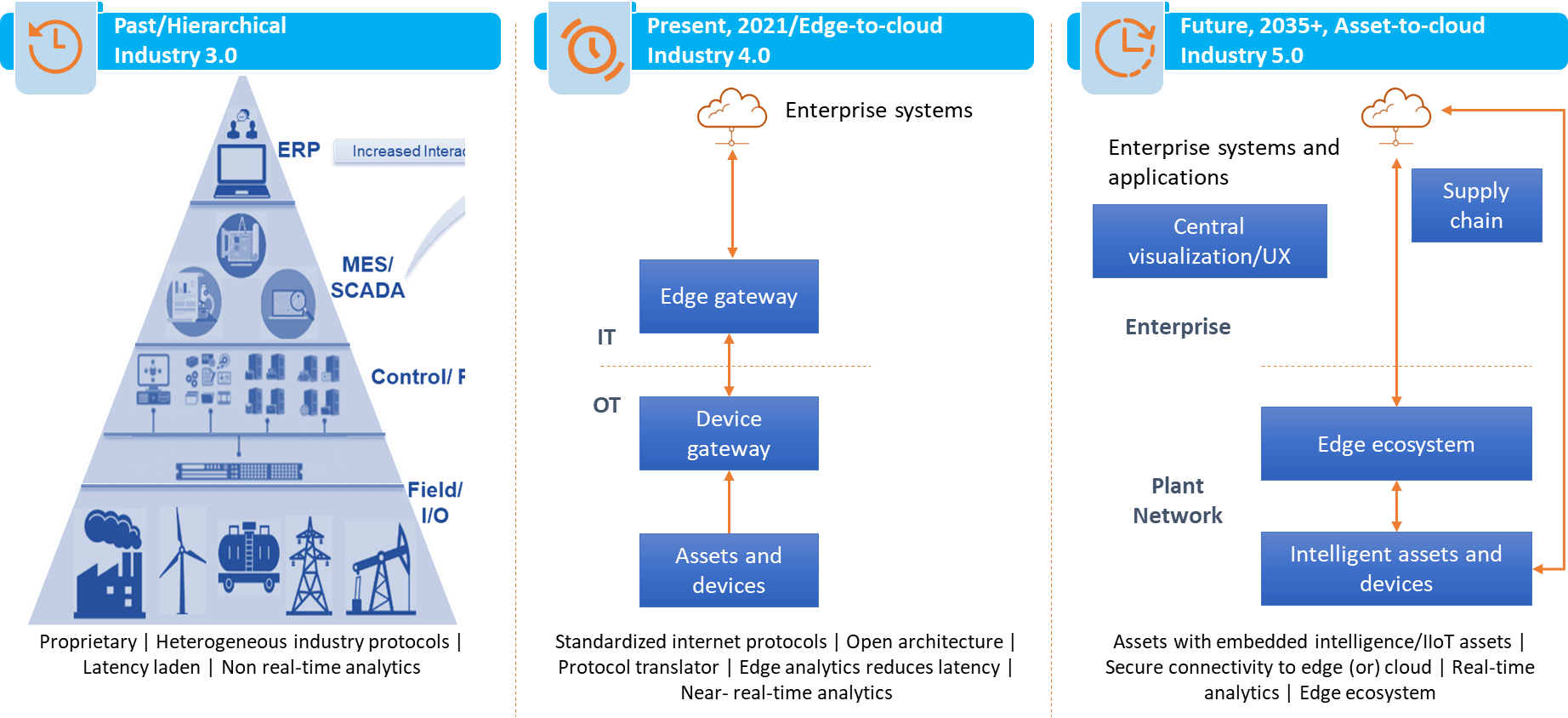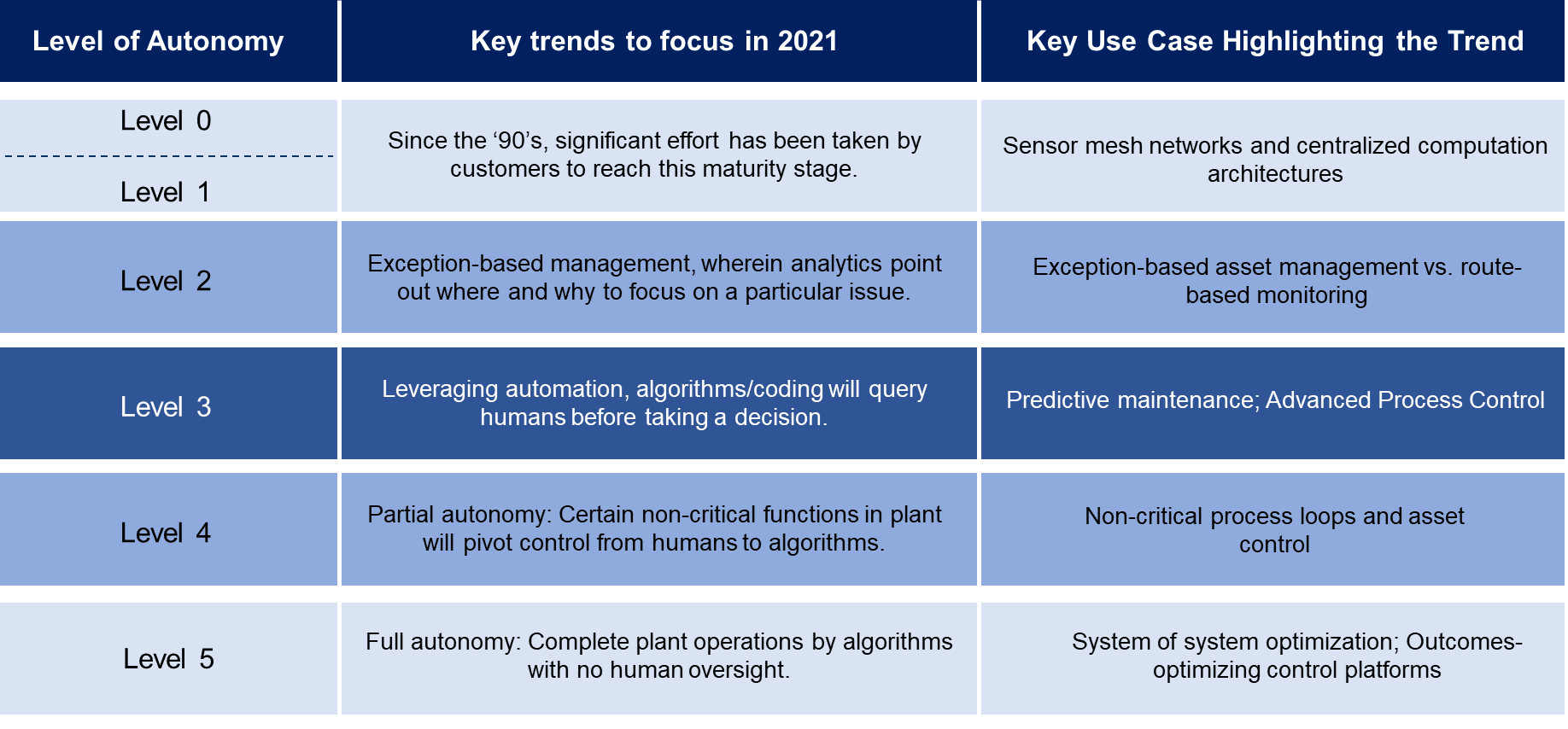Why, What, Who, and How? Futurecasting the Path to Autonomy
For over 60 years, the industrial and energy space has embraced automation technologies to drive process control and optimization. Now, dynamic technology refresh cycles are challenging the status-quo and steering organizations to push beyond limits and peek at what is beyond the obvious.
During Yokogawa’s 2021 virtual conference, Ram Ramasamy of Frost & Sullivan described the industry pivot from automation to autonomy as a progressive journey with novel opportunities emerging along its path. "People want to know what it looks like, why the industry should consider it, who is pushing the envelope, and how we see the future developing." The strategic importance of data-led transformation, best practices from the mobility industry, use-case examples, and a prescriptive house-view on balancing the risks were on the agenda.
State of Digital
Ramasamy began his presentation by describing the state of digital and outlined where the industry stands today, according to the recent Frost & Sullivan Global Cloud User Survey. "We firmly believe that the future of digital is flexible, open, and secure. Meanwhile, today's existing systems are proprietary and not scalable; they do not readily allow expansions. There is also no portability such as in terms of algorithms or applications software."
Among three key trends that Frost & Sullivan tracks is why digital is a competitive advantage. "Customers are investing in digital technologies such as sensor infrastructure that collects a massive volume of data, exception-based management, and predictive maintenance—these are the lowest hanging fruits of opportunity. In addition, the pandemic accelerated the digitalization journey. Now, 65% of the surveyed companies feel that they are digitally advanced. It shows a sense of confidence in the industry that digital investments have provided a competitive advantage.”
"The second trend is that security remains a top priority, as industrial companies seek to secure their solutions, Edge-to-Cloud. 62% are concerned about securing their data. Frost & Sullivan looks at security from five different angles, from enterprise-level security all the way to field asset or equipment security. Between those levels are data security, network security, and edge/node or endpoint security."
The third trend is the future of work, including the impact of the Cloud. "A new world—a new way of working—has emerged. Remote work will become the norm of the future. Industrial companies cite collaboration tools as the technology they implemented the most in 2020. 58% implemented such tools, and they have enabled improvements in productivity across remote and frontline workers. Meanwhile, hybrid cloud adoption has increased by 26%. Intelligent apps require flexible infrastructure environments—on-premises, Edge, and Cloud.”
"To take advantage of the greatly expanded amount of information that provides visibility to assets, securely and remotely, companies can pursue either of two strategies. In an Edge-driven strategy, everything is on-site/on-premises—everything happens at the edge layer. In an Edge-to-Cloud strategy, the Edge communicates with the Cloud."
Inhibiting Factors
As an inhibiting factor, Ramasamy stated that "there is an immense amount of technology debt. Inflexible information architectures and heterogeneous infrastructure in which companies have invested over time force site-based operational models. That needs to change. OT system architectures are based on the ISA95 Purdue Model, which is hierarchical. Companies should move to more flexible architectures.”
"Data silos continue to plague operational performance. Even with technological advancements, customers are struggling to connect and collaborate efficiently. 70 percent to 80 percent of an enterprise's data volume is generated at the edge level or operation layer. However, very little solution innovation has taken place to convert these data volumes to insights. Utilization is less than 7 percent.”
"We see, on average, a 50 percent shift of resources to address workloads to above-site level/exception-based management. Collaboration in terms of data—breaking the silos—creates a big opportunity. Operational productivity would increase by at least 20 percent when a central platform aggregates various strands of data."
Bottom-line is that "the primary challenge is obtaining a single version of the truth on a single pane of glass. This leads to performance variability."
Industry and Technology Trends
In terms of industry and technology trends, five key pivots drive the creative expansion of business models. The first is a pivot from a linear value chain to a circular, integrated value chain. As an example, Ramasamy mentioned a valve in a chemical process or refinery. "When the valve needs service, you call the OEM who refurbishes or replaces it. The process operator will incur downtime when the valve is taken out of service.”
"In a circular value chain, the valve is connected and monitored in real-time. The service provider can predict failures in advance and apply a service model, which minimizes or eliminates the downtime impact. The circular value chain also assures that the valve always operates near the design operating efficiency."

Industry and Technology Trends: Five key pivots drive the creative expansion of business models.
Ramasamy left the next two pivots, automation to autonomy and supply chain to demand webs, for further descriptions later and predicted that a large amount of computing power is migrating to the Edge, that is, the shop floor. Central computing is pivoting to decentralized computing. By 2030, 70 percent of industrial data will be processed at the Edge.
The fifth pivot point is the evolving transformation of the tech stack from the ISA95 model to a leaner, simplified, three-layer stack. Simplification allows end-users to best drive innovation and optimization. Today, as the architecture requires companies to "move people to the data," there is a lot of friction. "The leaner stack allows companies to move data to the people, which enables a cohesive, collaborative environment."

Technology stack transformation is inevitable as the industry pursues its journey to autonomy.
In terms of an architecture journey, today's application-based fusion, characterized by a distributed control system (DCS), will evolve to a decentralized architecture. Today, the DCS enables broad optimization throughout the plant. Illustrating the decentralized architecture are Edge computing platforms that are individually optimized to specific processes. The Edge platform is essentially a "mini DCS," which will have a very small footprint and be very scalable, even to the point where it operates a single loop. Furthermore, the Edge platforms will be very open and portable.

Process diversity leads to an application-centralized architecture.
Autonomy Maturity Model
Ramasamy next elaborated on the automation-to-autonomy trend. Company managers want to know where they stand in terms of autonomy now and how to progress to autonomous operations. A five-level maturity model describes the autonomy levels. For each level, Ramasamy provided use case examples and key trends to focus on for 2021.
While other sources would describe the progression from Level Zero to Level One in terms of an evolution from manual operations to automated operations, Frost & Sullivan instead uses intelligent sensors using mesh networks to communicate with central computing platforms. "While most people would say that they have been deploying sensors for the past 60 years, intelligence is the differentiator today."
Analytics that enable exception-based asset management characterize level two. Some companies have already moved to this level. "In the case of a refinery, when you have 15,000 assets, you cannot expect people to look at every one of them. Algorithms pinpoint issues and bring them to the attention of human operators. At this level, people still take action."
Level Three leverages automation technology. Algorithms can take action but will first check with humans. Ramasamy used the Mars Rover as an example. "Once the engineers have deemed an area to be safe, the rover can move on its own, within those bounds."
"Partial autonomy" is the description for Level Four. Certain non-critical functions will pivot control from humans to algorithms. Finally, Level Five, "full autonomy," is attained when algorithms conduct all operations with no human oversight. "The autonomous plant dynamically adjusts itself to conditions that it is facing. It constantly corrects and changes its position and KPIs to meet the desired outcomes."

The autonomy maturity model: where do we stand in the journey to autonomous operations?
Conclusion and Call to Action
Ramasamy continued, "The path to autonomy begins with business KPIs. There is a significant KPI disconnect throughout a typical company from corporate to engineering to operations today. Aligning on the business KPIs is extremely important. Start with the business KPIs and build the infrastructure around them."
He concluded his presentation with predictions for an autonomy roadmap in terms of six technology platforms through 2030. For instance, today, "we have smart sensors with embedded intelligence. Over the next few years, we will see fully orchestrated mesh sensor networks with self-healing and self-optimizing capabilities. They can sense problems, communicate with the Cloud, and develop preventative action mandates for the plant.
"The Edge platform, in 2018, was centralized but has since evolved to an affordable, open platform. By 2030, Edge devices will use highly deterministic communication protocols with near-zero latency, which enable application scalability and portability."
The other platforms include cybersecurity, which evolves to a zero-trust platform by 2030, advanced analytics, Edge apps, and services. Advanced analytics progress through application-specific analytics to a point where they process health and plant well-being. Formerly hard-coded, predefined Edge apps evolve to use an adaptable information architecture.
In 2018, lifecycle services with spare parts, version updates, and customer phone support characterized the last category. Now, it is evolving with connected services and outcome-based business models. By 2030, there will be self-optimization services.
The technology platforms are enablers, which progress in step with the autonomous operations maturity model.

Autonomy Roadmap through 2030 and beyond
Related Products & Solutions
-
Digital Transformation Consulting
DX Consulting provides advice and support with its global industry experience and vast technical expertise stemming from Yokogawa’s trusted digital technology and KBC’s years of improvement consulting.
-
Digital Twin
A digital twin is the key to effective decision making, providing deeper analytics technology and strategies to maximize profitability.
-
Digital Transformation
- Yokogawa's wide process manufacturing knowledge/expertise
- Digital transformation solutions for a better future for our customers